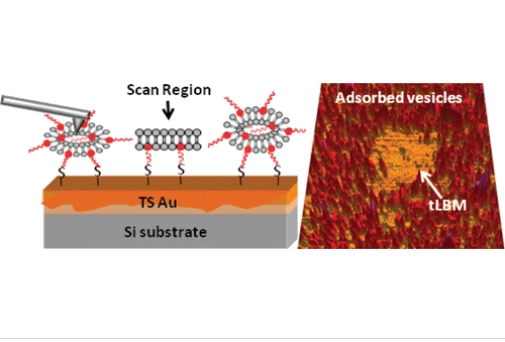DSPE-PEG-PDP调控金表面脂质体破裂行为及tLBM形成机制研究
DSPE-PEG-PDP自我调节金表面层脂质体龟裂活动及tLBM型成管理机制探析连接://pubs.acs.org/doi/abs/10.1021/la300127m作家:王曦马修·M·辛德尔王思文雷吉娜·拉根*前言:在水性树脂储存液状况下,运用氧原子力高倍显微镜 (AFM) 科研了脂质体(由大形单多层囊泡根据)与肌底外层左右的物理化学吸引力,实验设计其在金外层驱动包囊泡脱落和约束脂质多层膜 (tLBM) 成型的用途。将 1,2-二硬脂酰-sn-甘油-3-磷酸无水乙醇胺-N-聚乙二醇-2000 -N- [3-(2-吡啶基二硫代)丙酸酯] (DSPE-PEG-PDP) 调用到 1-棕榈酰-2-油酰-sn-甘油-3-磷酸胆碱 (POPC) 囊泡中,以促进会进行金-硫醇盐键成型的互为用途。在有构建压和无构建压状况下,AFM 测试检测器测试检测器成脂的诱发金外层囊泡脱落的力被细化为 DSPE-PEG-PDP 成分的指数函数。引致包包含 2.5、5 和 10 mol % DSPE-PEG-PDP 的囊泡脱落必备要的临介力分别是约为 1.1、0.8 和 0.5 nN。对待包包含 2.5 mol % DSPE-PEG-PDP 的囊泡,tLBM 成型必备要的临介力从 1.1 nN(无构建压)降到 0.6 nN(5 mM CaCl 2引致的构建压)。高达模型 5 nN 的力又不诱发纯 POPC 囊泡在金上成型 LBM。DSPE-PEG-PDP 仍然对待在金外层锚定和弯曲囊泡比较严重要。仅仅科研体现了如何快速运用能力性脂质来调接囊泡-外层互为用途,并展现了囊泡-底物互为用途在囊泡脱落中的用途。AbstractAtomic force microscopy (AFM) studies under aqueous buffer probed the role of chemical affinity between liposomes, consisting of large unilamellar vesicles, and substrate surfaces in driving vesicle rupture and tethered lipid bilayer membrane (tLBM) formation on Au surfaces. 1,2-Distearoyl-sn-glycero-3-phosphoethanolamine-N-poly(ethylene glycol)-2000-N-[3-(2-pyridyldithio) propionate] (DSPE-PEG-PDP) was added to 1-palmitoyl-2-oleoyl-sn-glycero-3-phosphocholine (POPC) vesicles to promote interactions via Au–thiolate bond formation. Forces induced by an AFM tip leading to vesicle rupture on Au were quantified as a function of DSPE-PEG-PDP composition with and without osmotic pressure. The critical forces needed to initiate rupture of vesicles with 2.5, 5, and 10 mol % DSPE-PEG-PDP are approximately 1.1, 0.8, and 0.5 nN, respectively. The critical force needed for tLBM formation decreases from 1.1 nN (without osmotic pressure) to 0.6 nN (with an osmotic pressure due to 5 mM of CaCl2) for vesicles having 2.5 mol % DSPE-PEG-PDP. Forces as high as 5 nN did not lead to LBM formation from pure POPC vesicles on Au. DSPE-PEG-PDP appears to be important to anchor and deform vesicles on Au surfaces. This study demonstrates how functional lipids can be used to tune vesicle–surface interactions and elucidates the role of vesicle–substrate interactions in vesicle rupture.



 pg电子娱乐游戏app
微信公众号
pg电子娱乐游戏app
微信公众号 官方微信
官方微信